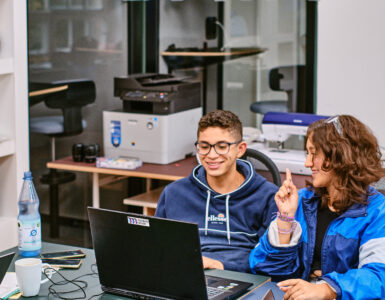by Claudia Hackl, Jana Herwig and Daniel Handle-Pfeiffer, Center for Teaching and Learning, University of Vienna, Austria
Making communities of practice in media & learning visible and tangible using the tools and interactions at hand. A report from the Center for Teaching and Learning, University of Vienna, Austria.
How do you gather a community of e-learning practitioners that neither consider themselves e-learning practitioners nor view themselves as a community? This is a challenge that virtually all universities and their centers for teaching and learning found themselves in at some point over the past two years. Given the often large numbers of teaching staff that now had to be converted to online teaching, scalable approaches were required that would equip lecturers both with the tools they needed and with the knowledge and support required to effectively use these tools in a teaching context. Scalability was particularly required at the University of Vienna Austria, considering its size of 90.000 students and 10.000 staff members, including > 7300 in teaching and research.
There is one thing that universities these days do not really have a shortage of and that is virtual space. Creating a new Moodle course requires a click of a button, and the tools and activities provided in each course range (at least with regard to the University of Vienna) from multiple video conferencing systems to various tools for communication, collaborative writing, file exchange, tests, quizzes etc. The challenge is to fill them both with content and interactions that are useful to the intended audience.
We looked for a solution that would cover all needs for information, support and exchange in one place. Using the university’s single sign-on, all requests for help were directed to the same destination: the Moodle Newsroom. Essentially, this is a Moodle course comprising all the service segments the University of Vienna has to offer, simultaneously addressing the technical and didactic aspects of using learning tools. As such, it gives access to webinars (and webinar recordings), online speaking hours, interactive lessons dedicated to key aspects of Moodle’s activities, course templates for various digital testing scenarios, forums for information and exchange, links to an extensive wiki platform dedicated to teaching in higher education as well as opportunities for feedback.
With Moodle being the central Learning Management system used at the University of Vienna, the Moodle system itself is the point of departure of each and every online learning activity at this institution. Using it also to provide support and information about online teaching is therefore a natural step in this process. Beyond this, the Moodle Newsroom is also a means of building awareness among teaching staff of their membership in a community of practice, making both visible and experiential the tools, skills and knowledge that are involved in digital teaching. If learning can be described as “increasing participation in communities of practice”, as Lave & Wenger (1991: 49) have argued, then it is vital to give teaching staff access to these communities and address them as members of such communities, in particular if they are (yet) unaware of their belonging.
Starting with the tools at hand and building interactions as they occur within the institution (e.g. directing lecturers who turn to the service desk to the Moodle Newsroom) is a practical approach at making such communities of practice tangible that can easily be implemented and adopted by other institutions of higher education.
To find out more about what we do, visit our website (in German).
Editor’s note: Claudia and Jana will be presenting at the Media & Learning Conference that will take place 2-3 June in Leuven, Belgium. More information about the conference can be found here.

Authors
Daniel Handle-Pfeiffer, Head of Digital Teaching, Claudia Hackl, Project manager OER and Jana Herwig, Project coordinator MOOCs, Center for Teaching and Learning, University of Vienna, Austria














